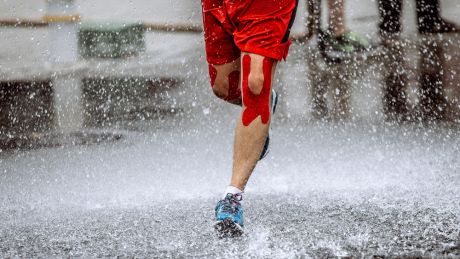Six Tips For Running In The Rain
Don’t let precipitation ruin your perspiration. Use this advice to get the most from a rainy run

Finding the motivation to get out of the door and run can be hard at the best of times, and if it’s raining, sleeting, hailing or snowing then the strong temptation is to sack it off and wait for fairer weather.
Unfortunately, if you’re in the middle of a training plan ahead of a big event, sometimes you can’t postpone a run because it’s raining – especially if it looks like it’s going to rain for days on end. Plus there’s every chance the race itself will take place on a rainy day.
“If you’re training for a run in Britain then you have to be prepared for a rain-soaked race – 133 days a year receive rain or snow,” says Graham Ferris, strength and conditioning coach at Pure Sports Medicine.
Fortunately, Ferris didn’t just bring doom and gloom with his precipitation stats. He also gave us some great advice on how to make the best of a rainy run, whether that’s a training session or a race.
1. Pick Your Footwear Carefully
“The sole needs to have a good tread to avoid slippery surfaces, not just for safety but also for force application,” says Ferris. “How can you propel yourself forwards if your feet just slide backwards? When it comes to a race, warm up in another pair of shoes and socks, and keep a dry pair for the race. These small things will keep your feet in better health.”
2. Make Yourself Chafe-Proof
“Chafing is very common during wet runs,” says Ferris. “Apply a layer of Vaseline to areas that are prone to chafing – inner thighs, armpits, sports-bra lining and your nipples.”
3. Dress For The Temperature, Not The Rain
While a waterproof top can be a useful during wet runs, it’s easy to overdress in the rain and make yourself uncomfortably hot.
Get the Coach Newsletter
Sign up for workout ideas, training advice, reviews of the latest gear and more.
“Wear a wind- or water-resistant layer over the top of a layer that wicks sweat away, but dress more for the temperature,” says Ferris. “It’s raining – you’re going to get wet.”
See related
- The Best Men’s Running Jackets
- The Best Running Shoes
- Running Motivation: Five Ways To Stop Winter Killing Your Running Buzz
- Winter Running: Gear And Tips For Runners Who Don’t Get On With The Treadmill
- Should You Run With A Cold? We Asked A Pharmacist
4. Go For That PB
“The rain can help stop your body temperature rising too high, which in turn promotes less thermic stress on the body, lower heart rate and perceived exertion,” say Ferris.
That’s right, the rain can be a good thing and can even help you chase down that elusive PB.
“Some studies have found almost 13 seconds knocked off 5km runs in recreational runners when using an effective cooling technique on the body,” says Ferris.
5. Embrace The Mental Challenge
“Some runners don’t mind the rain, because accomplishing something given the added challenge can be rewarding, but some dread it,” says Ferris. “Just keep reminding yourself that a warm shower is only moments away.”
Your rainy runs will build new confidence in your running, which can provide a welcome boost on race day.
“Changing your perception of the task in hand can be a huge factor in your success during arduous conditions,” says Ferris. “Is this race really as tough as that wet run you did a few weeks ago? Probably not. You’ve got this!
“Every time you successfully put your body outside of its comfort zone, your comfort zone increases. You become less nervous in these conditions and you psychologically feel steadier.”
6. Change, FAST
“Get out of your wet clothing as soon as you can after the run,” says Ferris. “Once you have stopped moving, your body is going to start cooling. You don’t want this to happen too rapidly in those cold and wet clothes or you might find yourself with early signs of hypothermia. Grab a bin liner and get yourself changed.”

Nick Harris-Fry is a journalist who has been covering health and fitness since 2015. Nick is an avid runner, covering 70-110km a week, which gives him ample opportunity to test a wide range of running shoes and running gear. He is also the chief tester for fitness trackers and running watches, treadmills and exercise bikes, and workout headphones.
